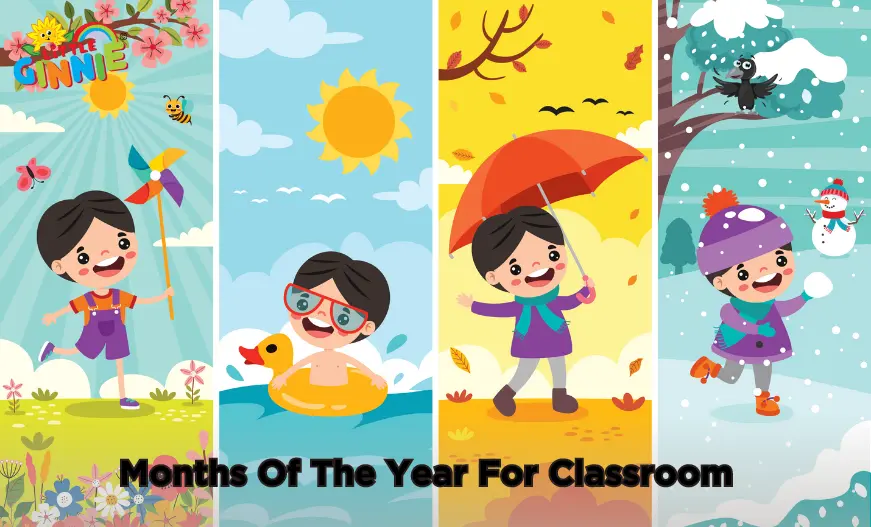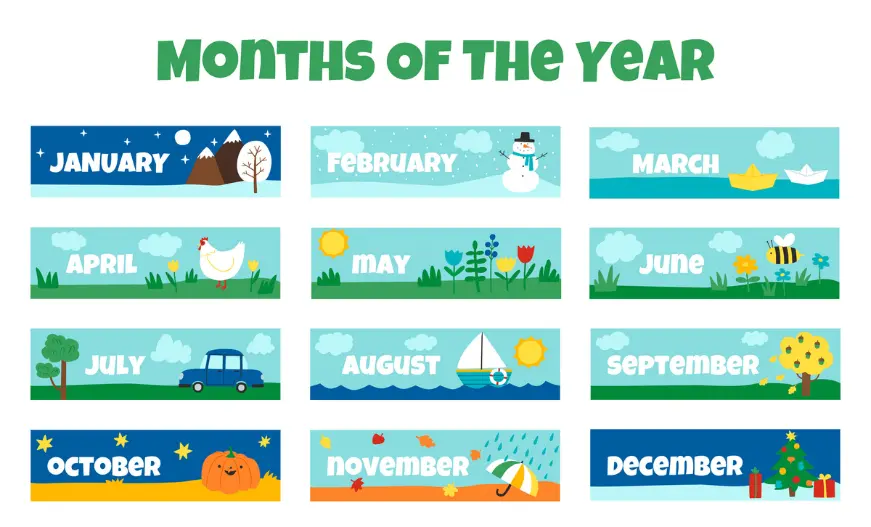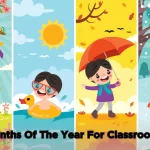
A year is divided into 12 months. Every month is different from the other in some way and has some unique features. The number of days, the kind of clothes we wear, the type of food we eat, and the availability of fruits and vegetables are some factors that differentiate one month from another. We humans remember these 12 months by our birthdays, our family’s and friends’ birthdays, and the seasons.
As children grow up, they notice the change in clothes they wear and the different food they eat in other seasons. They also observe that the month their birthday falls differs for their friend. That is why it becomes essential to teach them about the 12 months of the year so that they can understand the change in their surroundings and time. Since children celebrate various festivals throughout the year, learning about the 12 months of the year becomes necessary. It’ll help children keep track of important events, like birthdays, festivals they like, etc. Let’s see all the months of the year for classroom.
Months Of The Year For Classroom
The 12 months of the year for classroom you need to learn are January, February, March, April, May, June, July, August, September, October, November, and December. Let’s learn about the 12 months in detail:
1. January
January is the year’s first month, and January 1st is celebrated as New Year’s Day. It has 31 days. India experiences winter in this month. Teachers can encourage students to set goals for themselves to achieve in the year ahead. The students can also discuss one good habit they want to teach.
2. February
February is the shortest month of the year, with 28 days. But every four years, it gets an extra day, making it a month of 29 days. That year is known as the Leap Year, and the 29th day is called the Leap Day. Since the weather during this month is mild, the teacher can take the students on a nature walk and ask them to collect flowers, leaves and other natural resources they find.
3. March
It is the third month of the year and has 31 days. During this month, animals worldwide start emerging from their winter hibernation. This month marks the onset of the summer season in the Northern Hemisphere. In India, people celebrate the festival of Holi. Teachers can engage students in learning water-conserving activities on World Water Day, which falls on March 22nd.
4. April
April is the fourth month of the year and has 30 days. The first day of April is known as April Fool’s Day, when people make silly jokes and prank their friends and family. In April, students can engage in decorating Easter eggs. The teacher can also hide eggs in the classroom and ask students to find them by giving easy clues. The teacher can also engage students in planting trees on Earth Day on April 22nd.
5. May
May is the fifth month of the year and has 31 days. The second Sunday of this month is celebrated as Mother’s Day. Teachers can ask the students to bring pictures of their mothers and engage other students in guessing who is the mother of whom. Students can also be asked to make and decorate cards for their mothers.
6. June
June is the sixth month of the year and has 30 days. June 1st is World Milk Day, and Father’s Day is also celebrated in June. Since June falls in the monsoon season, the students can try making roasted corn or hot chocolate with the teacher’s help and enjoy monsoon delicacies.
7. July
July is the seventh month of the year, with 31 days. Because of the humid weather, it is considered one of the hottest months in India. During this month, the students can maintain a Nature Journal. They can draw and colour the page according to the weather and keep a logbook for the entire month.
8. August
August is the eighth month of the year and has 31 days. Indian Independence Day is celebrated on August 15th. Students can make Indian flags and tri-colour hand prints. The birth of Lord Krishna, Janmashtami, is also celebrated this month. Teachers can ask the parents to dress their child as Krishna or Radha. A story narration of Lord Krishna’s birth activity can also occur in the classroom with colourful props.
9. September
September is the ninth month of the year and has 30 days. In this month, India celebrates the festival of Ganesh Chaturthi. People bring the idol of Lord Ganesha and worship him. The students can play the ‘Mimic the Animal’ game. The teacher can encourage the students to mimic the movements of animals and make noises like them, like hopping like a frog or slithering like a snake.
10. October
October is the tenth month of the year, with 31 days. This month is full of festivities in India. People celebrate a nine-day festival of Navratri, followed by Durga Puja and Dussehra on the tenth day. Involve the students in making their dandiya sticks and hold a Dandiya Dance Party. Narrate the story of the victory of good over evil on Dussehra’s occasion with cutouts and props.
11. November
November is the eleventh month of the year, which is 30 days long. This month is packed with festivities and celebrations. November 14th is celebrated as Children’s Day, along with the celebration of Guru Nanak Jayanti. The festival of lights, Diwali, usually falls this month, followed by the festival of Govardhan and Bhai Dooj. The teacher can give the students sheets, crayons and paints and ask them to draw themselves. Then, they can be encouraged to speak on “What I Want To Be”. They can also make rangoli designs using non-toxic, food-safe coloured pasta and rice during Diwali and other festivals.
12. December
December is the twelfth and last month of the year, with 31 days. The festival of Lord Jesus’ birth, Christmas, is celebrated this month worldwide. Students in a preschool classroom can make Christmas ornaments and decorate the Christmas tree. The teacher can also sing Christmas carols and songs. Students can also play the game “Guess the Right Clothing,” where they can guess the clothes they wear in the winter season. They can also be involved in making hot chocolate using kid-friendly recipes.
Takeaways
We hope you like this blog on Months Of The Year For Classroom. There are 12 months in a year, and each month has something special and unique. The various festivals and celebrations spread throughout the year can be used to teach children something new and exciting. Each month brings something different, be it the season, the food or the clothes. Children will be able to learn about other cultures and types of seasons and get to know about themselves, too. They will also be able to observe the change in their surroundings through the nature walks that they take and the clothes they wear. The 12 months of the year will teach them about the different months and much more!









